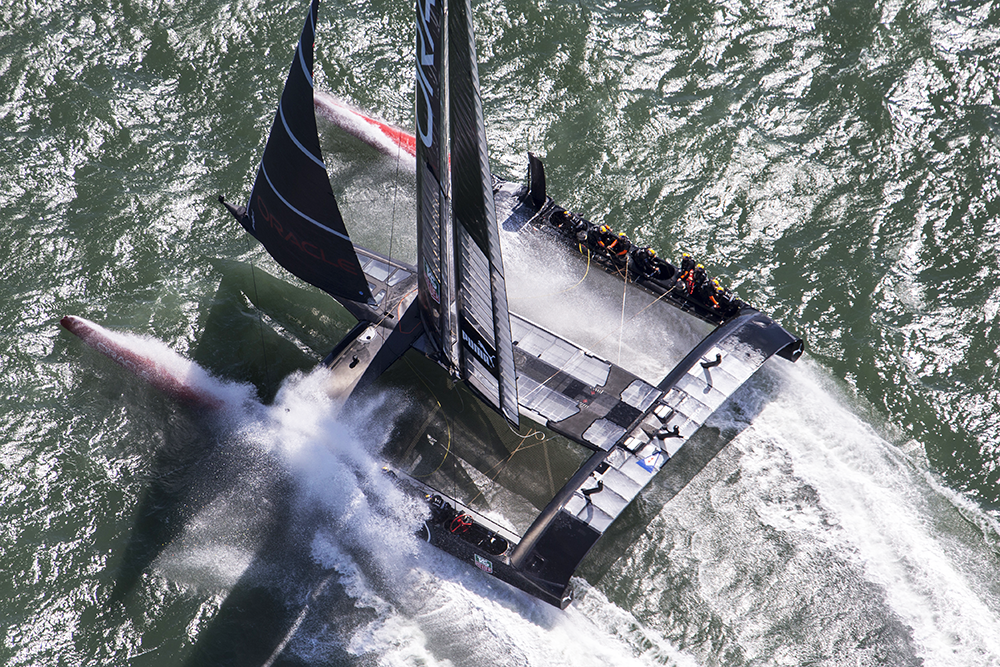
OK, the Protocol for the 35th America’s Cup has been published. Big deal, or great deal? That really depends on your point of view. The most important thing to remember about the America’s Cup is that it is not compulsory. If you don’t like the rules you have two choices, sit it out completely or challenge, win and impose your vision on the following cycle.
The current Defender, the Golden Gate Yacht Club (GGYC) went through that process a few times as a Challenger and as we know ultimately won the Cup in 2010 through a default match that had no Protocol. They then, by rights, imposed their vision on the 34th America’s Cup with a Protocol that brought in the Cup we witnessed last year in San Francisco. Their ultimate success with their defence last year again earned them the right, along with their chosen Challenger of Record from the Hamilton Island Yacht Club in Australia, to draft the recently published Protocol for the 35th America’s Cup cycle. This new document is to all intents and purposes an extension or refinement of the vision that the Golden Gate Yacht Club had in 2010.
What is the Protocol?
In simple terms the Protocol is the list of items of mutual consent found between the Defender and the Challenger of Record. Mutual consent is a big concept but it is basically about the points that the pair of yacht clubs must agree on, the who, how, when, with what and where sort of questions. One could compare the Protocol to a Notice of Race for a more conventional regatta, except that because the America’s Cup is a challenge driven trophy the ultimate document that drives its existence is a Deed of Gift. The America’s Cup’s Deed of Gift lists some default values for the next event should mutual consent not be found. We really don’t want to go down that path as it serves no one. Mutual consent is fundamental otherwise it’s a mess. So congratulations to both signatories for finding mutual consent. That is the first big plus in spite of the amount of time it has taken.
The key new points in this Protocol are in fact few. The regatta format is the single most important change with a full programme of racing planned from 2015 onwards, initially in AC45s and then the new big boat the AC62. This is similar to the plans for last time except for one fundamental difference, the America’s Cup World Series regattas are now worth winning as the champion and runners up will earn points to be used in later stages from these early events.
Regatta Format
If you are interested in winning the Cup the sporting path that you will have to pursue looks like this:
America’s Cup World Series (ACWS)
In 2015 and 2016 there will be between six and eight three-day regattas in the 2011-built AC45 One Design catamarans. It is possible that the AC45s become foil-born for the 2016 season. The venues, dates and regatta formats of these events will not be known until November 2014 and August 2015 respectively for the following years. Interestingly the challengers can apply to host an ACWS event in their country. The final decisions on the where and when these events will happen will be made by ACEA.
America’s Cup Qualifiers
This part of the project sees a double Round Robin of Match Racing sailed in the new AC62 Class of boat and significantly will include the Defender competing against all the Challengers. The AC62 is a new class that will be obviously smaller than the AC72 of the last Cup but with a lot fewer restrictions with regard to foiling mechanisms. The class rule defines various other elements about supplied components but the significant things are to do with how many boats can be built be each team, the challengers can build one boat each and the Defender can build two boats, essentially identical, but the second one cannot be sailed until after the Qualifiers have concluded.
The team that comes into the Qualifiers with the highest score from the previously sailed ACWS events will be assigned some extra points based on how many competitors there are in the event. For example if there are seven or fewer entries two points for the winner and one for second place taken into the Qualifiers. Eight or nine entries 3, 2 and 1 points respectively and so on.
The two significant parts of this event are firstly, that only four challengers make it out of this round, the fifth, sixth and seventh challengers, if there are that many, are eliminated from further competition at this stage and will need to put their brand new AC62s away, and secondly, if the Defender wins the Qualifiers it will start the America’s Cup Match with a point in hand. If a Challenger wins the Qualifiers and subsequently advances to the Match it will start with a point in hand. If the eventual winner of the Qualifiers doesn’t get to the Match then the Match starts with a balanced scoreboard.
AC Challenger Playoffs
This is the equivalent of the Challenger Selection Series Semi Finals and Finals, or the meat end of what was once known as the Louis Vuitton Cup. The highest scoring Challenger from the Qualifiers chooses his opponent for a best of nine series, the other pair do the same thing and the winners of these two semi finals repeat the process in the Challenger Finals to determine the identity of the Challenger that will meet the Defender later in the Match. This part of the event will be sailed in the same venue as the Match and is likely to take three weeks and will end only a few days before the Match begins.
In parallel the Defender gets to run a 30-day Defender Series at the same time with their second boat AC62 if they build it.
35th America’s Cup Match
A best of 13 first to seven points series will determine whether the Defender keeps the Cup for another cycle or whether the Challenger changes status and becomes the new Defender. One or the other protagonists may start the series a point up if either one of them had previously won the Qualifiers.
For now we are assuming the last three components of the programme are all going to take place in 2017. Significantly the Protocol allows the Qualifiers to take place in a venue different to the Playoffs and the Match. The dates and venue(s) for these three events will be announced on or before 15 February 2015.
Momentum
The Protocol in past editions has sometimes been published the day after the Defender has either successfully defended or a new Defender has been crowned. For the last America’s Cup it took nine months for the Protocol to see the light of day. For sure that Protocol brought in a sea change in many things to do with the America’s Cup, but a long delay between the last Match and the next Protocol often breaks the momentum and rhythm for teams, sponsors, media and fans.
The 34th Cup ended in September 2013 and the new Protocol was published nine months later, and three months late. Why the delay? We don’t know the details but if there had been all the answers on the table that satisfied both parties earlier then maybe signatures would have been placed on the document earlier. We’ll never know, we can only imagine the reasons for the delay. But it is fair to assume that the texts were finalized after significant negotiation, stand-offs and, how shall I put it, the Sword of Damocles dangling nearby.
Has the delay broken the momentum of one of sport’s most amazing comeback stories? It may have done in terms of winding up the show again and in reality the Protocol is still silent on many important issues in particular the name of the venue for the Match and venues and dates for the earlier qualifying events.
Although those of us on the outside have only have been able to analyse these documents recently we can safely assume that the prospective challengers have been kept fairly well informed of developments over the last few months and that there are few real surprises in this text for them in spite of current media excitement.
Entries
Who can play? The usual rules about defining a Challenging Yacht Club apply except that this time only one challenger from each country can enter. To keep teams on their toes there is a really short window of time (9 June – 8 August 2014) in which to enter, and the entry fee is much higher than in the recent past – US $1.075m must be paid before the entry deadline and a further US $1m must be paid by 14 December 2014 along with a US $1m Performance Bond.


